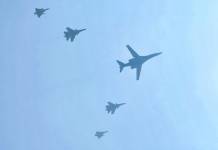Iran Revolutionary Guard Corps (IRGC) said on Wednesday that it had launched a military satellite into orbit amid escalating tensions with the United States. There was no immediate confirmation of the launch, which the Guard called “Noor” or light on their official Sepahnews website.
The US State Department and the Pentagon who have long contended that these launches advance Iran’s ballistic missile program did not immediately respond to a request for comment.
However, the launch has given an impetus to rumor mills who are speculating whether the technology used in the launch of the satellite could help the Islamic Republic to develop intercontinental ballistic missiles aimed at possibly targeting various locations in the Middle East, Europe, and the US.
IRGC claimed that the satellite which was carried by a rocket bearing a Quranic verse about overcoming adversaries successfully orbited above the Earth’s surface at 425km (264 miles). The launch was carried out from the desert southeast of Tehran in an area called the Dasht-e Kavir in the early hours of Wednesday.
However, some experts believe that the launch took place from a previously unnamed Guard base near Shahroud, Iran, some 330 kilometers (205 miles) northeast of Tehran in Semnan province which houses Imam Khomeini Spaceport that operates civilian space program.
IRGC said a previously unheard satellite carrier system Ghased or “Messenger” which uses both solid and liquid fuel was used to put the device into space. Tehran has in the past collaborated with Russia, China, and Thailand on joint research projects.
Tehran’s first major breakthrough was Omid, a domestically made satellite. It was sent into orbit in 2009 on an indigenous missile. Iran launched imaging satellites in 2011 and 2012.
The surprise launch has come more than two months after Iran’s failed attempt on February 9 to put into orbit Zafar 1 (meaning “Victory” in Persian) satellite just before the 41st anniversary of the Islamic Revolution.
Tehran had asserted back then that the satellite had no military application. That failure followed two failed launches of the Payam and Doosti satellites last year, as well as a launchpad rocket explosion at its Semnan site in August and a separate fire incidence at the Imam Khomeini Space Centre in February 2019 that killed three researchers.
The US alleges such satellite launches defy a United Nations Security Council resolution calling on Iran to undertake no activity related to ballistic missiles capable of delivering nuclear weapons.
American officials, as well as European nations, worry that these launches could help Iran develop intercontinental ballistic missiles capable of carrying nuclear weapons. Tehran, however, retorted that it hasn’t contravened any UN resolution on its ballistic missile program as the International body only “called upon” Iran not to conduct such tests.
The launch of military satellites is of special interest given that it has been launched by IRGC, an elite force which operates its own military infrastructure parallel to Iran’s regular armed forces and is a hard-line force with significant sway over Iranian affairs and is answerable only to Supreme Leader Ayatollah Ali Khamenei.
The IRGC has displaced not only part of Iran’s economy, foreign policy, intelligence services, and government but also the army, air force, and now space program.
According to the Jerusalem Post, IRGC head Hossein Salami while applauding the achievement said, “We have made a leap in the field of expanding territory and strategic intelligence…Today, we can see the world from space, and this means expanding the strategic intelligence of the powerful defense force of the Islamic Revolutionary Guard Corps,” he said.
“The deployment of this multi-purpose satellite in space, both in the field of information technology and intelligence battles, can produce strategic added value for us, and in intelligence warfare, it creates powerful grounds for us.”
He went on to note that achieving these technological successes for “Islamic Iran” is important because it makes Iran a member of one of the world’s top technologies. “We now form the front lines of technological talents…the launch of the satellite is not limited to defense and military issues, adding that the realization of this important goal will lead the country to great progress in various fields, so it is a strategic achievement for our Islamic system.”
If the satellite actually has all the capabilities that Iran asserts it has, then it has a lot of ramifications for the Middle East as it can provide images and other information to IRGC who has sought to create long-range military capabilities to challenge the US and Israel in recent years and has proved successful in some attacks, such as the one on Saudi Arabia using 25 drones and cruise missiles in September 2019.
Middle-East Heading Towards a Deadly Nuclear Arms Race Thanks To US – OpEd
It is unclear whether Iran’s civilian Government was in the loop about the launch as President Hassan Rouhani gave nearly a 40-minute speech on Wednesday before his Cabinet that did not include any mention regarding the upcoming launch.
Iran’s previous assertions that it does not seeks nuclear weapons and its satellite launches and rocket tests do not have a military component will now be called into question as Wednesday’s launch has raised new suspicions.
While Iran isn’t known to have the know-how to miniaturize a nuclear weapon on a ballistic missile, any advances toward an intercontinental ballistic missile would put Europe and potentially the U.S. in range.




